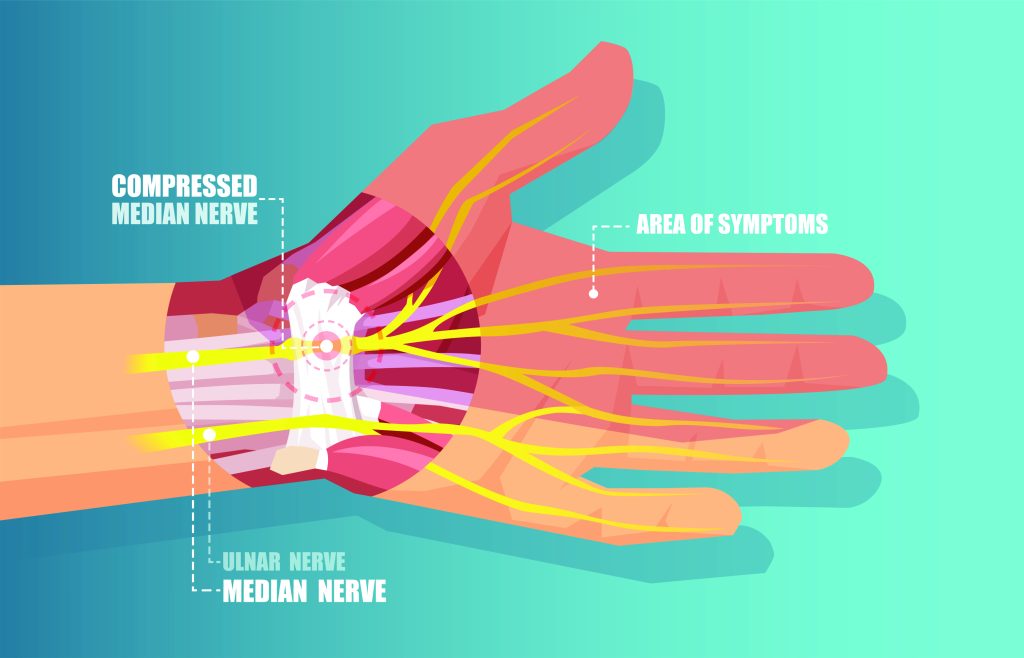Carpal tunnel syndrome
This information is useful for those who have been diagnosed with carpal tunnel syndrome. People who are experiencing new or ongoing symptoms should contact a healthcare professional for assessment and diagnosis.
Read more about self-managing a wrist, hand or finger problem
What is carpal tunnel syndrome?
Carpal tunnel syndrome is a common condition affecting the median nerve as it passes through a narrow tunnel in the wrist.
The carpal tunnel is made up of the bones of your wrist, called carpals, and a thick ligament. The tunnel contains the tendons that bend your fingers and thumb as well as the median nerve.
Sometimes the nerve gets squashed and causes symptoms such as pain, numbness, burning or tingling in your thumb, index and middle fingers and part of the ring finger.
Symptoms are often worse at night or first thing in the morning. It may also become a problem when holding an object such as a phone, book or steering wheel, when your wrist is bent forwards and your fingers are in a fist position.
This can result in feelings of weakness and clumsiness in the hand with reduced sensation and reduced grip strength.

What causes carpal tunnel syndrome?
This condition can appear without any apparent reason, however, your risk of developing carpal tunnel syndrome can increase if you have:
- a job that involves repetitive activity involving your hand
- diabetes (Type 1 and 2)
- inflammation of the tendons
- fracture at the wrist
- rheumatoid arthritis in your wrist joint
- pregnancy
- menopause
- thyroid problems
How is carpal tunnel syndrome diagnosed?
The main way carpal tunnel syndrome is diagnosed is by a healthcare professional examining your wrist and hand. As the symptoms of carpal tunnel syndrome are similar to other conditions, they may assess other areas of the body, particularly the neck.
Nerve conduction studies can also be performed but are not essential to make a diagnosis.
Blood tests are sometimes taken to see if there is another condition that may be contributing to the problem.
How is carpal tunnel syndrome treated?
For all wrist problems it’s important to remain active and effectively manage your pain levels.
Try to vary your activities during the day ensuring that you aren’t doing lots of repeated squeezing, gripping or wringing.
Try to alternate between heavier and lighter activities to reduce any strain. Consider other ways of doing a task to reduce this or increase the amount of rest you take between such activities.
You can use padded handles for cycling, gardening or golf.
Be aware of your wrist position and try and avoid having it bent in either direction for any prolonged period of time.
Wrist splint
A wrist splint is often advised by your healthcare professional as a first treatment option. The aim of the splint is to keep the wrist straight at night. This shouldn’t stop you from keeping your wrist mobile during the day.
A splint can be used at night to stop you bending your wrist whilst sleeping as this position can squash the median nerve.
You may sometimes need to use a splint during the day when carrying out repetitive activities, it’s not advised to wear this all the time. You may only need to use this for a few weeks in order to settle the symptoms.
Exercises
Targeted wrist exercises to encourage movement, stretching and strengthening can help to improve your wrist and hand movement and pain.
Read about exercises for wrist, hand and finger problems
Managing pain
Pain medication can help you move more comfortably, which can help your recovery.
Corticosteroid Injections
If painkillers aren’t helping to control the pain, your healthcare professional may discuss the option of having a corticosteroid injection into your carpal tunnel.
Corticosteroids are medicines that help reduce pain and inflammation. They may also be given with a local anaesthetic.
Injections may not cure your condition, they are used to help with the pain.
Read more about corticosteroids
Surgery
In some cases, surgery may be an option if all other treatment options have been tried. The operation is called a carpal tunnel decompression and involves reducing the pressure on the nerve by opening the roof of the tunnel.
Work
Carpal tunnel syndrome can sometimes mean you need to take some time off work to help recovery. How long you’re off will depend on the nature of your condition and your role at work.
You do not need to be symptom free before you consider returning to work. Continuing to go to work, or returning to work as soon as is possible for you, will help your recovery. Gradually getting back to your normal daily activities can help to build up your strength and stamina levels.
Help and support
Following this advice, you should see gradual improvements over time.
If your symptoms haven’t improved, or it’s got worse, within 6 weeks of following this advice, talk to a healthcare professional about your symptoms.
Find out how to access MSK services in your area.
When dealing with any health condition it’s important to also look after your mental wellbeing as this can impact your recovery.

Source: MSK Expert Panel - Opens in new browser window
Last updated:
16 June 2023